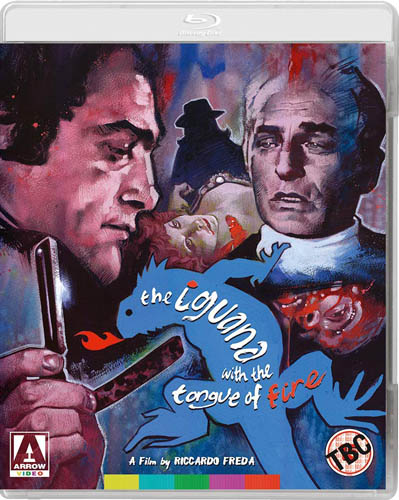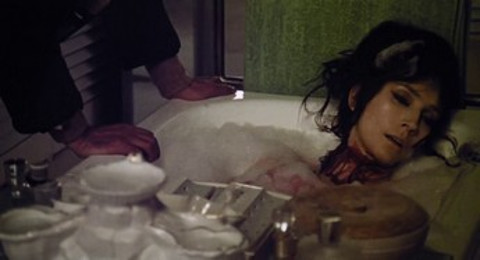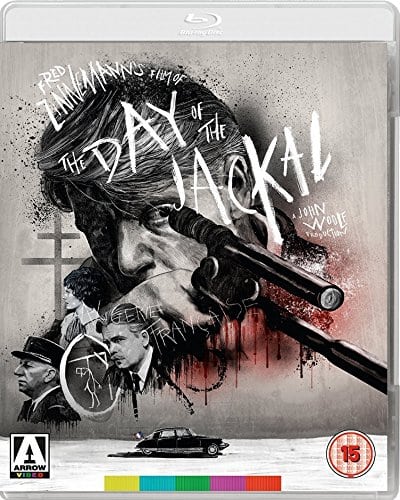The Iguana with the Tongue of Fire (1971)
Directed by: Riccardo Freda
Written by: André Tranché, Günter Ebert, Riccardo Freda, Sandro Continenza
Starring: Anton Diffring, Arthur O'Sullivan, Dagmar Lassander, Luigi Pistilli
AKA L’IGUANA DALLA LINGUA DI FUOCO
Italy/France/West Germany/Ireland
AVAILABLE ON BLU-RAY: NOW, from ARROW VIDEO
SOUNDTRACK AVAILABLE ON VINYL: 19th APRIL
RUNNING TIME: 94 mins
REVIEWED BY: Dr Lenera, Official HCF Critic
In Dublin, a young woman is murdered in her home by somebody who throws acid in her face and then slits her throat with a razor. Her body is later discovered, mangled and unrecognisable, in the boot of a limousine owned by the Swiss Ambassador to Ireland Sobiesky. Frustrated by their lack of progress, the police bring in the unofficial help of ex-Inspector John Norton, who was kicked off the force after a man he was violently interrogating blew his own brains out. Then a nightclub singer who was Sobieski’s mistress is also found killed, and Norton thinks that the best way for getting information is through Sobieski’s lovely daughter Helen….
The Iguana With The Tongue Of Fire, whose title is given one of the lamest of explanations ever half way through [though it seems like they’re really talking about a chameleon?!], is hardly one of the best of the wave of gialli that came out in the genre’s bumper year of 1971, though while watching it I did wonder if it was partly intended as a spoof, what with things like its often idiotic dialogue [only slightly less so if you watch the Italian language version], and its repeated camera zooms into the faces of suspects, while hardly anybody behaves like a real human being. Much rougher around the edges than normal, not very interesting visually and with little of the style that even lesser gialli often have to burn, it sometimes looks and feels like a Lucio Fulci film, though even he wouldn’t have used quite so many zooms into faces as you get here, and there’s only one genuinely bravura set piece in this movie whereas Fulci, at least in his earlier days, would have had several – and even that’s too short. Nonetheless giallo fans should still find a fair bit to enjoy, including several really vicious moments and a plot that teases the viewer in a fun way several times and which actually hangs together reasonably well – even if the revelation of the killer hardly matters much in the scheme of things.
It’s actually quite an obscure giallo, only ever getting one release on DVD [in Germany], though oddly this time around there’s a little bit of information on it to be found without ploughing through the special features on the Blu-ray. Its director’s fame relies largely on two films: Caltiki The Immortal Monster which he co-directed with Mario Bava, and The Horrible Dr Hitchcock. Riccardo Freda was winding down a career that had began in 1942 and mostly consisted of historical dramas when he made this film, a project which he seems to have initiated. The opening credits state that it’s based on the novel A Room Without a Door by Richard Mann, but it appears that the novel and its writer were made up, something that was nothing new. The screenplay was written by Freda and Sandro Continenza, the other credited writers André Tranché and Gunther Ebert being credited solely for co-production reasons [four countries were responsible for making this one]. Freda wanted Roger Moore [!] for the lead role, but he was unavailable. It was shot on location in Ireland especially Dublin, in Switzerland for a short period, then at a studio in Rome. Freda was unhappy with the finished product and had his name on the credits replaced with the pseudonym “Willy Pareto”, while the German co-producer Artur Brauner thought it to be so poor that he decided not to release it in German cinemas. Of course it did come out in Italy but grossed poorly at the box office.
Boy does the film show off where it was shot, with a very travelogue-like opening before we cut to a county garden at night and pan to a house window. Freda handles the archetypal slasher-style murder build up well enough as we adopt the point of view of a killer in his [or her] victim-to-be’s house watching her in her lounge through a doorway, after which she goes to make a phone call and finds that the line has been cut. The acid on the face of a very obvious mannequin doesn’t really convince especially when the next shot but one is of the actresses face which looks very different, but the sheer savagery of the attack, which also includes very gory throat slashing, still startles. The police are understandably baffled by the list of suspects, most of whom you know are hiding something even if they aren’t the killer, though there’s a little less sleaziness than normal going on in this particular group, and what there is is more suggested. There’s the arrogant, cheating Ambassador Sobiesky himself – and yes, that is Anton Diffring in the role even though the voice you’re hearing isn’t his. Then there’s also his opium addicted wife Mrs Sobiesky, neurotic stepson Marc, pretty daughter Helen, the sweaty chauffeur Mandel, and others. The killer wore dark glasses, so the film decides to show that nearly everybody else happens to own a pair too, something usually accompanied by a sinister musical effect that you’ll soon laugh at. Then there’s a Dr Johnson hinting that he could have done it, replete with close zooms into his razor and scissors, while I assume that the ridiculous dialogue was intended to be laughed at, such as “When will you learn that if you don’t wear your glasses you can’t hear anything”, and this exchange after the killer has sent the police the victim’s passport: “What there’s nothing else, not even a letter?” “What did you expect? The murderer’s name and address? An invitation to tea between 5 or 6?” “No, you never know”. And PC types will cringe at: “The use of vitriol does suggest a woman’s hand or a coloured person’s“.
With idiots like this in the force it’s perhaps not that surprising that somebody sacked for being so incompetent as to beat a suspect to within an inch of his life but be unable to stop him from shooting himself is reinstated to hunt down this murderer. We flash back to this traumatic event three times though it’s kind of amusing really the way that it’s done. John Norton is played by giallo fav and all-round Italian cult cinema legend Luigi Pistilli, though considering how totally and utterly Italian he looks, surely they could have got someone who appeared slightly less Latin considering the thick Irish accent his character is given in the English language version? After all, there are a few actual Irish actors dotted about. He’s still cool though, so much so that it’s not totally unconvincing when he’s able to give Helen a lift home from the nightclub where she was at with another guy on his motorbike, charm his way into the Sobieski household [sample line: “Are we going to have it off in the bushes or on the bike?”] and turn around to find that Helen has stripped off for him! The singer at this club is the next victim, though not before we see her blackmailing the Ambassador. The pace is swift enough to maintain interest and the killings do eventually pick up again. You probably really will think that the culprit is one particular person before being proven wrong – though this misdirection could have been kept at for even longer if the script hadn’t casually thrown this element away. There’s not a great deal of suspense and we only witness two of the many murders, but there aren’t many films that do the ‘dead cat in a fridge’ routine with as much blood, or which climax with a teenage girl being beaten up and an old lady having her head repeatedly bashed against a wall – though you won’t be able to miss one of the most obvious head pieces in movies, and I mean obvious!
There’s certainly a crude effectiveness here and there, and Freda , who gives us not one but two protracted fight scenes full of ‘shakycam’ and exaggerated sound effects [though the first feels very much like padding], does seem to really invest in a very atmospheric nighttime chase scene, and, while that scene could be longer, you can’t really say that the daft way that it ends isn’t in keeping with the general goofy approach of the film despite its few moments where Freda just seems to want to shock the viewer in the manner of a naughty child. After all, this is a film where its hero has a mother who thinks that she’s an expert mystery solver and logically comes to the conclusion that a little girl is the killer. Where a small boy is indifferent to the sight of a body in the trunk of a car and calmly looks up at the sky. Where somebody with conjunctivitis can be a chauffeur. Where one can walk straight into the operating room of a hospital and get seen to immediately]Where somebody can have an appalling looking toboggan crash but wind up with just a mildly injured leg. And what are what are we to make of a curious moment, set on a cliff edge for would-be dramatic effect, when Norton looks like he’s about to strangle Helen before embracing her? After all, we never think for a second that the killer could be him despite a bloody cloth being found in his bathroom cabinet later. And, while I said earlier that the basic plot hangs together fairly well, so many knowing glances between characters remain unexplained. We’re sometimes asked to think that certain details, like some cigars, will be important, but quite often they’re not.
Valentina Cortese chews the scenery as Mrs. Mrs Sobiesky, while Dagmar Lassander looks as stunning as ever despite as usual playing a hard to understand character. There’s not much in the way of stylish outfits and interiors: the Dublin setting [which incorporates a place called Swastika Laundry which the audio commentary tells us is real] of this one ensures that this giallo doesn’t seem to take place much in that cosmopolitan, chic world most of these movies seem to exist in – though the way folk act and talk it doesn’t really take place in anything resembling the real world either. There isn’t even any J & B whisky despite several visits to pubs and several other alcoholic beverages being on display with their labels turned towards the camera. Stelvio Cipriani’s music score sometimes sounds like a dry run for his work on Baron Blood, with a very similar lounge-type main theme and chase sequence scoring. Said main theme appears in various guises including as a wordless song, though it’s another, rather overused theme that dominates in a decent but not outstanding effort, and there are a few poor transitions where pieces suddenly out cut as we change scene, in a film that does have some technical flaws like dark moments where you can hardly see anything. The Iguana With The Tongue Of Fire is all in all a relatively minor giallo while I don’t feel that Freda, much more at home with more Gothic material, cared much about it overall – unless of course he and co-writer Sandro Continenza were trying to make a send-up. It intrigues me the way that this film frequently seems on the edge of becoming a genuine spoof of the genre without totally crossing the line. All the signs to me suggests that they set out to make a serious film, then realised that few would take it seriously – or vice versa. This means that the result ought to be a hoot for seasoned giallo watchers and which I had an absolute ball with [hence my star rating] – though others may just be baffled.
Arrow’s Blu-ray presentation of The Iguana With The Tongue Of Fire is just a notch or two from the best giallo restorations from Arrow. Softness is sometimes present and there’s the odd shot of uneven grain management, but overall the film still looks very impressive even though this is one of the less colourful gialli visually that I’ve seen. Detail is generally excellent and blacks in the several black-dominated bits have no crush. The English dubbing really isn’t too bad even though you get various accents on offer, and everyone is obviously speaking the language even if given somebody else’s voice. The Italian soundtrack is quite faithful in meaning even though a few variations do turn up according to the subtitles. I’d love to know what language the screenplay was written in. My guess is English, even though the writers were Italian.
With no special features to port over unless you count a German-language visual essay, Arrow have treated fans of this film to a very fine selection of new special features. The audio commentary with “giallo connoisseurs” Adrian J. Smith and David Flint is one of the most fun talk tracks I’ve heard in a while. The two spark off each other and can’t help chuckling at what they’re watching but still give us much observation and insight even though they obviously haven’t been able to unearth much background information about the production. They’re well aware of its shortcomings [though I personally don’t think the special effects are as bad as they make out], but clearly like the film and find things to praise such as a few good scenes of drama which they say almost seem to come from a different film. You’ll love watching the movie again with these two and I hope that they stick around for more Arrow releases.
Of Chameleons and Iguanas has features critic Richard Dyer giving a nicely balanced look at the film, saying how it’s interesting thematically especially with its portrayal of family, but how it doesn’t hang together and is a bit flat so it’s more random aspects tend not to come off. Them we have a welcome return for soundtrack aficionado Lovely Jon with Considering Cipriani, in which he discusses the composer’s background and the development of his sound, saying also how ahead of his time he was with regard to things like multi-tracking, before delving into the soundtrack of The Iguana With The Tongue Of Fire, discussing its main theme and three key musical scenes. What I really love about this guy are his enthusiasm and his ability to explain music in ways that virtually anybody would understand. The Cutting Game has editor Bruno Micheli talk about his start as an editor and his work on what seem like sex films for much of the time, films where “hard” inserts would be shot and cut if necessary. He also discusses some of the particulars of editing, and we learn that Freda fired the original female editor, and that production manager Alfonso Donati would often get angry on set if stuff didn’t look good. And The Red Queen of Hearts is another chat with Lassander, who says that she never felt objectified and whom one critic called “the parsley of Italian cinema” because of all the large and small roles that she had, about her career. Stories about Lucio Fulci you will have heard before, but she discusses others, and we get a sad insight into how things were for her and other actresses, with the agents making every decision and often firing women who got married or pregnant. She seems to have enjoyed her time though for the most part. And we finish off with the usual trailers and promotional material, but the latter includes a photo novel that races through the plot but extends the sex scenes, showing that quite a bit of naughty material was cut from the film. I wonder if an uncut version exists somewhere? Hmmmmm…..
You could possibly call The Iguana With The Tongue Of Fire a bad movie, but watch it as a lark and there’s a hell of a lot of fun to be had, though perhaps more for seasoned giallo watchers than anyone else. The special features all add value. Maybe Arrow treat it better than it deserves, but you have to admire their dedication to the cause. Overall this release comes Recommended.
SPECIAL EDITION CONTENTS
*New 2K restoration from the original 35mm camera negative
*High Definition Blu-ray (1080p) presentation
*Uncompressed mono 1.0 LPCM audio
*Original English and Italian soundtracks, titles and credits
*Newly translated English subtitles for the Italian soundtrack
*Optional English subtitles for the deaf and hard of hearing for the English soundtrack
*New audio commentary by giallo connoisseurs Adrian J. Smith and David Flint
*Of Chameleons and Iguanas, a newly filmed video appreciation by the cultural critic and academic Richard Dyer [21 mins]
*Considering Cipriani, a new appreciation of the composer Stelvio Cipriani and his score to The Iguana with the Tongue of Fire by DJ and soundtrack collector Lovely Jon [26 mins]
*The Cutting Game, a new interview with Iguana’s assistant editor Bruno Micheli [21 mins]
*The Red Queen of Hearts, a career-spanning interview with the actress Dagmar Lassander [20 mins]
*Original Italian and international theatrical trailers
*Image gallery
*Reversible sleeve featuring original and newly commissioned artwork by Graham Humphreys










Be the first to comment